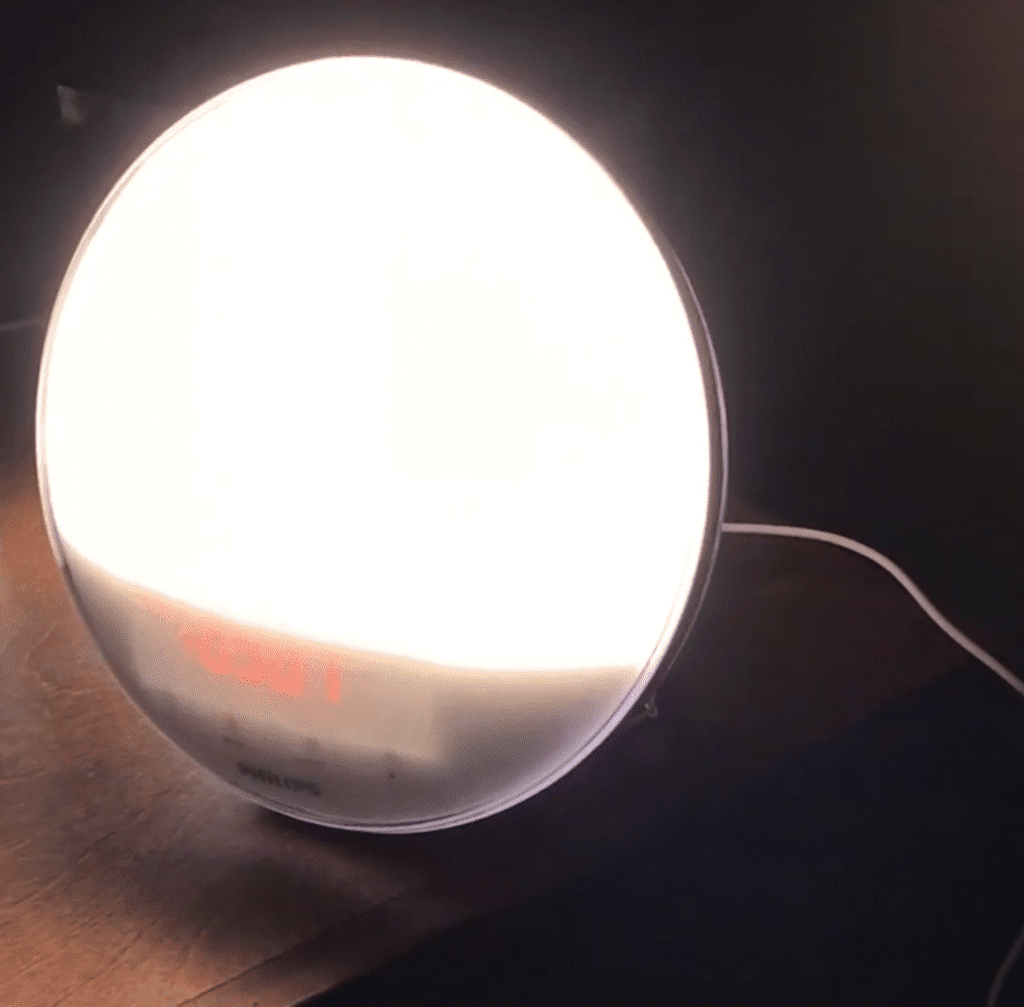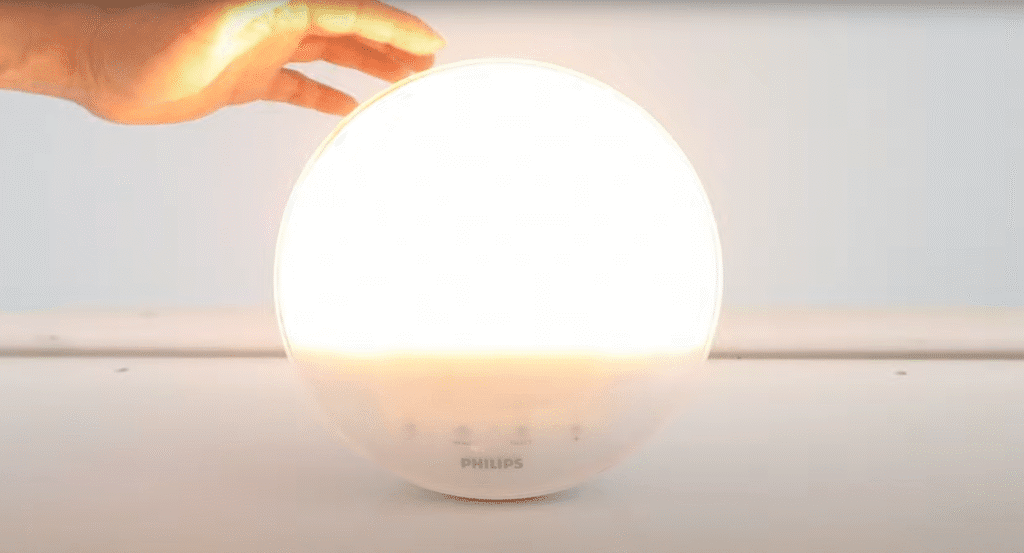Philips SmartSleep Wake-up Light Review: Say Goodbye to Groggy Mornings
Ever jolt awake to the piercing shriek of your phone alarm, heart racing after being yanked from deep sleep? You’re not alone.
Research reveals that half of us rely on phone alarms to wake up—that jarring blast that jolts our nervous system awake and leaves us feeling groggy and stressed before we’ve even gotten out of bed.
The Philips SmartSleep Wake-Up Light (HF3520/60) takes a different approach. Instead of shocking you awake, it gradually fills your room with warm light over 20 to 40 minutes, paired with gentle natural sounds. Your body responds to this simulated sunrise, helping you wake up more refreshed.
For those who prefer smartphone integration and more advanced features, the Hatch Restore 3 offers app controls and a wider range of soundscapes. Both options are great for moving away from traditional alarms toward something that works with your body’s natural rhythms rather than against them.

Disclosure: As an Amazon Associate I may earn a small commission from qualifying purchases at no extra cost to you.
Philips SmartSleep (HF3520/60): Key Features & Real-World Use
The Philips SmartSleep Wake-up Light caught my attention with its sleek round design and impressive range of features. The LED light cycles through 20 brightness levels, starting with a soft red glow that gradually transitions to bright white light—just like actual sunlight. Your body responds by producing cortisol, the hormone that makes you feel alert and energized.
But the magic doesn’t stop with light. Five natural wake-up sounds accompany the visual sunrise: bird songs, ocean waves, gentle chimes, and more. There’s even FM radio if you prefer your local morning show. The sounds start whisper-soft and build over 90 seconds, creating a peaceful audio backdrop.
Beyond morning duties, this device doubles as your bedside lamp with adjustable brightness perfect for reading. The sunset simulation mode works in reverse, gradually dimming to help you wind down for sleep.
It’s like having your own personal sun that rises and sets on command.
Philips SmartSleep Setup & Everyday Usability
I’ll be honest—I expected setup to be complicated. It wasn’t. The Philips SmartSleep Wake-up Light has a touch-sensitive interface right on the front that responds immediately to your finger. No confusing button combinations or tiny text to squint at.
The menu system walks you through everything step by step. Alarm times, wake-up sounds, light intensity, display brightness—it’s all laid out clearly. As a bonus, this smart wake-up light comes with two separate alarm settings. My partner leaves for work an hour before me, so we each get our own wake-up time without disturbing the other.
Need those extra few minutes? Just tap anywhere on the device for a 9-minute snooze. Simple.
How Does the Philips SmartSleep Wake-Up Light HF3520/60 Work?
The gradual light increase from this smart alarm clock works even through closed eyelids. Your brain starts registering that soft glow about 20 minutes before your alarm, gently pulling you from deep sleep.
The difference in how I feel is noticeable. Instead of that jarring “where am I?” confusion from traditional alarms, I wake up feeling… normal. Alert, even (depending on how many hours I got in). My morning grogginess disappeared almost entirely.
The forest birds wake-up sound became my go-to choice—it creates this peaceful forest atmosphere that makes getting up less of a battle. The ocean waves option is lovely too, though I found the chimes a bit too zen for my taste.
FM radio reception works well in my bedroom, though your mileage may vary depending on where you live. The sunset mode surprised me with how effective it is for winding down. Fifteen minutes of gradually dimming light actually does help signal bedtime to your brain.
Design and Features
The SmartSleep Wake-up Light has a sleek, modern design with a round face. The light emanates from the entire front surface, creating a soft, diffused glow.
The clock display and touch-sensitive controls are discreetly integrated into the bottom portion of the device.

Key features include:
- 20 light intensity levels
- 5 natural sounds + FM radio
- 2 separate alarms
- Sunset stimulation
- Snooze function (9 minutes)
- Automatic dimmable display
The sunrise simulation begins 20-40 minutes before your set alarm time, gradually increasing in brightness to your chosen intensity level. This mimics the natural progression of dawn, allowing your body to wake up more naturally.
The plastic housing feels solid in your hands, not flimsy or cheap. Those touch controls have held up perfectly despite daily use—no dead spots or lag.
From what I’ve seen in reviews and forums, people are still using these devices years later without problems.
Drawbacks to Know
Let me be upfront about the downsides. The device is relatively large compared to traditional alarm clocks, so it may take up dominate the space on your nightstand.
The touch controls can be a bit overly sensitive, so you may occasionally activate functions you didn’t mean to. The lack of battery backup also means the device will reset if there’s a power outage, though it does keep settings when unplugged for short periods. There is no smartphone integration.
The price point is higher than basic alarm clocks, which may be a consideration if you’re watching your wallet. However, waking up in a better mood just may be worth the trade-off.
Who Should Buy the Philips SmartSleep?
If you’re one of those people who hits snooze five times every morning, this could change your life. I especially recommend it for anyone dealing with those brutal winter months when sunrise happens after you’re already at work.
Do traditional alarms make you want to throw your phone across the room? Same. This gentler approach might be exactly what you need.
It’s also fantastic for couples with different schedules. My partner and I wake up at completely different times, and the dual alarm feature prevents the early riser from disturbing the other person.
If you’ve been curious about light therapy for seasonal blues or just want to improve your overall sleep-wake cycle, this device delivers both benefits in one package.
Final Verdict: Is the Philips SmartSleep Wake-Up Light Worth It?
The Philips SmartSleep Wake-Up Light (HF3520/60) delivers what a phone alarm can’t: a calm, light-led wake-up that feels more natural, plus pleasant sounds and a helpful sunset mode. If you’re after something simple and reliable without relying on an app, it’s a great pick.
While it comes at a premium price, the potential benefits to your sleep quality and morning routine could make it worthwhile coming into winter. The device’s additional features, such as the sunset simulation and bedside lamp functionality, add value beyond just being an alarm clock and it’s not likely to break anytime soon.
For those who dread the sound of their alarm each morning or struggle with seasonal mood changes, the Philips SmartSleep Wake-up Light could be a game-changer. It brings a touch of sunrise to your bedroom, no matter the season or weather outside.
If calmer mornings is the goal, start with Philips SmartSleep; if you want guided wind-downs and app control, try Hatch Restore 3.
Frequently Asked Questions
How long does the sunrise simulation last?
The sunrise simulation can be set to last between 20 to 40 minutes before your alarm time. You can adjust this duration to find what works best for your wake-up routine.
Can the Wake-up Light help with Seasonal Affective Disorder (SAD)?
While not specifically designed as a treatment for seasonal affective disorder (SAD), many users report mood improvements, especially during darker winter months. The light simulation can help regulate your circadian rhythms, which may reduce some symptoms associated with SAD.
Is the Philips SmartSleep Wake-up Light HF3520/60 easy to set up and use?
The initial setup of the Philips SmartSleep Wake-up Light HF3520/60 is straightforward, but there’s a slight learning curve to master all functions. Most users find it intuitive after a few days of use.
Can I use the Philips SmartSleep Wake-up Light HF3520/60 as a regular bedside lamp?
Yes, the Philips SmartSleep Wake-up Light HF3520/60 functions well as a reading lamp with adjustable brightness levels to help ease eye strain.
How long do the LED lights last on the Philips SmartSleep Wake-up Light?
The LED lights on the Philips SmartSleep Wake-up Light HF3520/60 are designed to last for many years without needing replacement.

